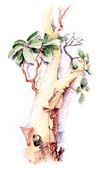

|
Plant Profiles: Arbutus menziesii
Broadleaf evergreen I have no need to embarrass myself waxing eloquent over our native madrone. The besotted writer Bret Harte beat me to it in his poem, "Madrono": Captain of the Western wood,
It gets worse, but I now understand why. The species invites hyperbole. Arbutus menziesii is not just a tree, it's a sentient creature with curative powers that are drawn from the very soul of the Pacific Northwest. Hey, this isn't opinion. This is folklore. Hasn't anyone ever told you to hug a madrone? I was encouraged to do so by an Oregonian, my mentor in most things horticultural. He offered no explanation, so I have none to give you. All I know is, hugging that tree felt awfully good. A. menziesii is easily identified by its sleek, papery, burnt-orange bark peeling to a lascivious smoothness too stimulating to be legal. Clusters of white, heather-bell blossoms give way to a profusion of tiny orange-red fruits. It's native from Northern California to British Columbia and inhabits a variety of sites, from hot, dry lowlands to windswept ridgetops 5,000 feet high. Madrone grows on rock at the northern end of its range, but farther south where the rainfall is less ample, it grows in grasslands and forests. Stunningly adaptable in the wild, A. menziesii is less than flawless in the home garden. Given its preference for the harsh life (hot sun, exposed bluffs, and summerlong drought), the plant is less resilient in a pampered garden setting here in the Pacific Northwest. If overwatered or nicked by a lawn mower, it can fall prey to a gross assortment of fungal diseases, including root rot, which can be fatal in a poorly drained site. I tell you all this not to dissuade you, but to alert you. Losing a cherished madrone has got to hurt. Another option is to try your hand at the Mediterranean hybrid, A. 'Marina', all in all a better garden plant. It has similarly gorgeous bark, pink-blushed fall flowers, and slightly larger, shockingly bright fruit. It's also less fussy, and more resistant to disease, though reportedly less handy. But if you've got the room, the patience, and access to seed or seedlings (digging them out of the wild is not an option), plant a grove of A. menziesii and then practice what the dean of Northwest native plant gurus, Arthur Kruckeberg, calls, "studied neglect." Choose the right site -- the edge of a woodland, away from lawn mowers and overhead sprinklers. Water carefully until established, then leave them be. Otherwise, should you opt to simply admire them in the wild, be sure to give a big guy a hug for me.
Plant Profiles are excerpted from Plant This! by Ketzel Levine
Copyright © 2003 National Public Radio, Washington, D.C. |
